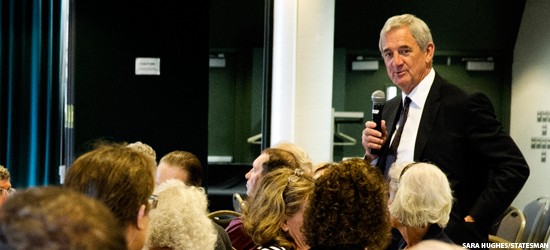Congressman Nolan says no to Syria and yes to college affordability
Sep 13, 2013
In The News

While Congressman Rick Nolan visited UMD on Sept. 4, a call from Washington D.C. revealed the latest information on the Syrian crisis.
“It would cost $500 million to set up the strike on Syria, and it will cost us $1 billion a week, and that’s with no boots on the ground,” Nolan said.
Nolan recalled costs of the Iraq War, where the combat operations alone were estimated to be about $1 trillion, an equivalent to the national student debt.
“For what we spent in Iraq in one year, we could’ve educated every student in America without having to have a loan,” Nolan said. “So, people need to put this in perspective. That’s why I’m opposing the war in Syria.”
Deciding how to budget money is just as difficult of a task for Chancellor Lendley Black as it is for Congressman Nolan. And while UMD looks to prioritize its budget, so is Congress.
This was precisely the reason for Nolan’s visit. In an effort to gain a better understanding of what people in the eighth district want to see done with federal dollars, Nolan hosts public forums.
“I value your opinion much more than the so-called ‘think tanks’ in Washington, D.C.,” Nolan said. “It’s always been my sense, in most cases, (that) the American people are ahead of the political leadership, whether it be St. Paul or Washington, D.C.
These forums, held throughout the state, ask participants to become Congress for the day. At UMD, those involved in the exercise were a variety of faculty and staff, as well as members of the community and Duluth’s political leaders.
Everyone was assigned to a committee tasked with finding ways to reduce the federal deficit over the next ten years. This is the goal of the Concord Coalition, which helps lead the discussions in partnership with Nolan.
According to the Concord Coalition, the federal deficit was $1.1 trillion in fiscal year 2012, due to the discrepancy between spending and revenue. If such a discrepancy were to continue, the Congressional Budget Office estimates this deficit will reach $6.3 trillion in the next decade.
Not alarmed by such hefty and startling numbers? Consider the standard notation: $6,300,000,000,000. If you’re still unfazed and accustomed to hearing the word “trillion” tossed around like a dirty dollar bill, check out: http://www.pagetutor.com/trillion/index.html.
Areas of defense, healthcare, social security and taxes were examined to see what should be funded more or less. Participants focused on both the long- and short-term economic effects, while also taking into consideration public policy—e.g., What parts of society will be affected by this decision? Is reducing the deficit a primary goal? Is government too big or too small?—and politics, e.g., How will the public react?
With the ideas presented in this exercise, a deficit reduction of $5.4 trillion is possible. Likewise, more spending and reducing revenue could result in a $5.6 trillion deficit increase.
The first question of the exercise asked members whether or not the federal government should create infrastructure to repair and modernize public schools. For this particular question, answering yes would increase the deficit by $30 billion but would also put people back to work.
Chancellor Black and his committee answered this with a no vote, arguing that it is the responsibility of the state and local government.
Other questions related to education—such as reducing funding for the arts and humanities, as well as grants for the Department of Education—were a quick and easy no for many of the participants.
“The heart of our economic success as a nation is education and preparation of our youth,” Nolan said.
Nolan said higher education has changed a great deal since he graduated from the University of Minnesota in 1966, but he still finds it one of the “most valued universities in the country.” But it’s only valued if students can afford it.
“It was very doable to work your way through the university,” Nolan said. “And that’s not true anymore.”
The cost of one year for a full-time, in-state undergraduate at a public four-year university averaged $17,860 in 2012-2013, according to data collected by College Board.
Currently at UMD, the cost is $23,464—over $5,000 more than the national average from last year.
Issues:
